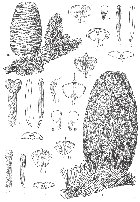
Line drawing; for full size image go to the Flora of China (Wu and Raven 1999), which also has some photographs.

Line drawing; for full size image go to the Flora of China (Wu and Raven 1999), which also has some photographs.
Abies forrestii
川滇冷杉 chuan dian leng shan [Chinese] (Wu and Raven 1999); Forrest fir (Farjon 1990).
I here follow Farjon (2010) in designating four varieties:
Abies chengii was an interesting case, having been described solely on the basis of material collected in arboreta in England, Scotland and Ireland, derived from seed collected in Yunnan by George Forrest in 1931 (Farjon 1990), and Farjon (2010) concludes that "it is more probably another variety (or a mere form not deserving a botanical name) of A. forrestii." No comparable trees have since been reported in habitat.
Trees to 40 m tall and 150 cm dbh with a straight, round trunk and broadly conical crown. Bark first smooth, brown-gray, with age becoming dark brown and longitudinally fissured. Twigs purple- or orange-brown, graying with age, smooth or finely grooved, glabrous or pubescent. Buds ovoid, 4-10 × 3-7 mm, resinous. Leaves spirally inserted, densely crowded on shoot in several ranks, parting in the middle, 2-3 cm × 2-2.5 mm, linear, flat, dark green or somewhat glaucous above, with a midrib and two whitish stomatal bands below; apex usually notched but sometimes obtuse, acute or acuminate. Pollen cones lateral, 3-4.5 cm long (the largest I have seen reported in Abies), yellow with purple microsporophylls. Seed cones lateral, thick, cylindrical with obtuse or depressed apex, 6-10 × 4-5 cm, purple-blue with blue bracts ripening dark brown, disintegrating to leave a very thick rachis. Seed scales 20 × 18 mm, puberulent, outer margin entire; bracts spathulate, variably exserted, straight or recurved. Seeds brown, obovate, 8 mm long with a 10 mm obovate light brown wing (Farjon 2010, Wu and Raven 1999). See García Esteban et al. (2004) for a detailed characterization of the wood anatomy.
Farjon (2010) distinguishes the varieties as follows:
| Variety | Characters |
| forrestii | Shoots glabrous; leaf resin canals marginal and small; cone bracts only slightly exserted or sometimes included. |
| ferreana | Shoots pubescent; leaf resin canals medial; cones small, 6-8 cm long. |
| georgei | Shoots with a dense, rust-colored pubescence; leaves 1.5-3 cm long with slightly revolute margins; cone bracts exserted, broad and tapering to a short cusp. |
| smithii | Shoots pubescent; cone bracts exserted, broad and abruptly narrowing to a long cusp (photo at the Flora of China). |
China and Tibet: NW Yunnan, SW Sichuan and SE Xizang (Tibet) in high mountains at 2400-4300 m. The climate is cold and wet with annual precipitation of 1000-2000 mm, producing grey-brown podzol soils. Typically found in pure stands near tree limit, or mixed with Picea likiangensis, Larix potaninii, Tsuga dumosa and some broad-leaved trees, e.g. Betula albo-sinensis, Acer spp. and Sorbus spp. at lower elevations (Farjon 1990).
Hardy to Zone 7 (cold hardiness limit between -17.7°C and -12.2°C) (Bannister and Neuner 2001).
The varieties have each been assessed for conservation status. Vars. ferreana and georgei are "least concern" while vars. forrestii and smithii are "near threatened" (Zhang et al. 2013, accessed 2022.03.20).
A tree-ring chronology covering the period 1348-2007 (659 years; crossdated after 1357) was collected in Sichuan by W. Wright, J. Li, K. Fang, Y. Tao, and E. R. Cook (doi.org/10.25921/by0y-ef68). This was part of a larger effort to develop a dendroclimatic reconstruction of long-term variability in monsoonal precipitation (Cook et al. 2010). Also, the work by Panthi et al. (2018) involved collection from living trees of a tree-ring chronology covering the period 1636-2015, indicating that they found trees at least 379 years old.
Formerly the prime low-elevation stands were heavily logged, but now are protected. In Europe and North America it is a popular ornamental, common in arboreta, where it is often mislabeled Abies delavayi (see the Taxonomic Notes for that species). As is often the case, the ornamental stock is almost all descended from a few early collections (Farjon 2010).
No data as of 2023.02.22.
Named for George Forrest (1873-1932), who collected it in China. Forrest made five collecting trips to China, supported by the nurseryman A.K. Bulley, and introduced many new species to science. Forrest led an adventurous life; here's a good story about him. He is also remembered in Pseudotsuga forrestii and Tsuga forrestii.
Cook, E. R., K. J. Anchukaitis, B. M. Buckley, R. D. D'Arrigo, G. C. Jacoby, and W. E. Wright. 2010. Asian monsoon failure and megadrought during the last millennium. Science 328:486-489. DOI: 10.1126/science.1185188.
Farjon, Aljos. 1990. Pinaceae: drawings and descriptions of the genera Abies, Cedrus, Pseudolarix, Keteleeria, Nothotsuga, Tsuga, Cathaya, Pseudotsuga, Larix and Picea. Königstein: Koeltz Scientific Books.
Panthi, Shankar, Achim Bräuning, Zhe-Kun Zhou, and Ze-Xin Fan. 2018. Growth response of Abies georgei to climate increases with elevation in the central Hengduan Mountains, southwestern China. Dendrochronologia 49:1-9.
Rushforth, K.D. 1983. Abies chengii, a previously overlooked Chinese silver fir. Notes of the Royal Botanical Garden, Edinburgh 41(2):333-338.
The species account at Threatened Conifers of the World.
Wu and Raven (1999) (the Flora of China).
Last Modified 2025-02-19